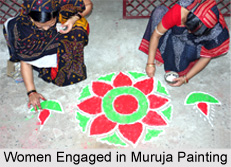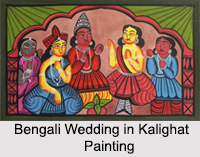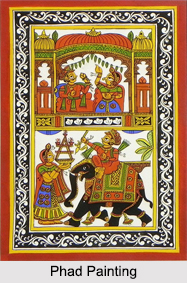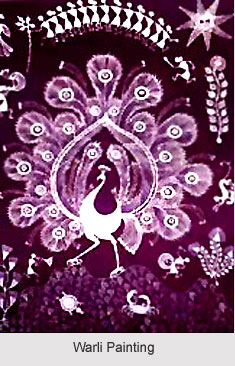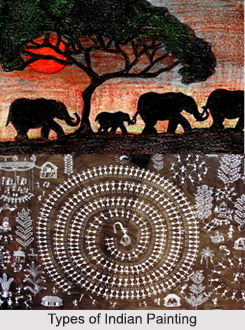 Numerous types of Indian painting have emerged in the due course of time in different geographic locations as a result of religious and cultural impact. Different types of Indian painting evolved in different periods of history. The paintings of India can be broadly classified under ancient paintings, medieval painting and modern paintings. The different types of Indian paintings fall under these three broad categories but again they can also be classified depending on their evolution, emergence and style. Indian paintings can further be classified according to their different origin. The technique and medium are the two major aspects of painting. With the border of art shrinking and the world becoming a global village, huge patterns of art form are in vogue. Finally, religion and culture also have immense impact on paintings.
Numerous types of Indian painting have emerged in the due course of time in different geographic locations as a result of religious and cultural impact. Different types of Indian painting evolved in different periods of history. The paintings of India can be broadly classified under ancient paintings, medieval painting and modern paintings. The different types of Indian paintings fall under these three broad categories but again they can also be classified depending on their evolution, emergence and style. Indian paintings can further be classified according to their different origin. The technique and medium are the two major aspects of painting. With the border of art shrinking and the world becoming a global village, huge patterns of art form are in vogue. Finally, religion and culture also have immense impact on paintings.
Paintings of Ancient Period
Almost all of the ancient paintings are engraved on the wall of temples and caves. Mostly the paintings on the walls of caves and temples depict many aspects of Hinduism and Buddhism.
•Cave Paintings: Indian cave paintings are regarded as the earliest evidences of Indian paintings that use the cave walls and palaces as canvas. There are several styles that can be recognised. This starts from prehistoric cave painting of Bhimbetka and flourishes through cave paintings of Ajanta caves, Ellora caves and Bagh. Bhimbetka of Madhya Pradesh records a range of prehistoric paintings discovered in numerous caves. Cave Paintings of Ajanta and Ellora refer to the Buddhist monks who employed painters to draw the life and teachings of Lord Buddha , Jataka on the walls of the Ajanta caves. The figures along with their costumes and jewelleries in beautiful colours and style can be manifested in Ajanta while Ellora caves have the paintings that are mostly of Hindu deities.
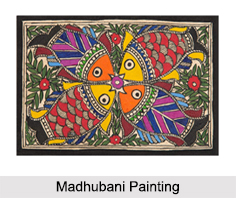 Paintings of Medieval Period
Paintings of Medieval Period
Miniature paintings are the ones made on small canvases of papers and clothes. This type of art mainly evolved in the medieval age narrating the royal life which is quite popular now. The miniature paintings of medieval period blossomed under the observation and patronage of a number of kings and royal patronage.
•Mughal Paintings: Paintings of the Mughal are the amalgamations of Indo-Islamic style of painting which flourished in the ateliers of Mughal emperors including Akbar, Jahangir and Shah Jahan, delineating neatly the court life of Mughal royal society. Tanjore Paintings are classical South Indian form of painting which evolved in the village of Thanjavur in Tamil Nadu state well-known for its richness and compactness of forms and vivid colours.
•Rajasthani Paintings: Rajasthani painting has clear influences of Mughal paintings though it is quite distinct in its own way. Different parts of the state stick to their own style, and are thus recognized as different schools of paintings. A number of famous schools of painting are Mewar, Hadoti, Marwar, Kishangarh, Alwar and Dhundhar.
•Madhubani Paintings: Women belonging to the small town called Madhubani and other villages of Mithila mainly do Madhubani Paintings or Mithila Paintings. Formerly they were made on mud walls of small hut but now they are carved on paper and clothes also. The subject involves Hindu Gods and Goddesses, the natural objects like moon and sun, sacred plant like Tulsi and its specialty remains in use of vegetable colours.
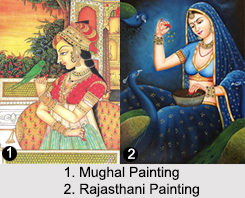
•Pahari Paintings: Pahari Painting is the miniature painting with beautiful scenes of Himalaya as the backdrop. Evolved in the hilly states of Himachal Pradesh, Punjab, Jammu and Kashmir during the period of Rajputs they have an essence of rugged nature. There are three distinct schools named Basholi, Guler-Kangra and Sikh.
•Warli Paintings: Warli paintings of Maharashtra are closely linked with nature and social rituals of the tribe. Warli paintings showcase daily activities of the local people of that community like farming, dancing, hunting, praying, etc.
•Lepakshi Paintings: Another type of Indian painting is the Lepakshi Painting; a wall painting made on the walls of temple of Lepakshi, a small village in Anantpur district of Andhra Pradesh.
Indian Folk Painting gives a pictorial expression of village painters, which are marked by the subjects chosen from epics like Ramayana and Mahabharata and other mythological stories.
•Patachitra: Patachitra flourishing in the state of Odisha is made on cloth with extremely vivid colours and mythology-based subject.
•Kalighat Painting: Kalighat pots are another form, which are made on earthen pot or cloth and find their use as wall hangings.
•Batik Painting: Batik Painting or wax writing refers to the technique which involves waxing and de-waxing and subtle use of colour shades. The process is popular in West Bengal, Odisha, Tamil Nadu states and is used for dress materials, wall hangings, scarf, etc.
•Kalamkari: Kalamkari is the form of art that involves weaving and block printing apart from painting.
•Silk Paintings: Silk Paintings provide the charm and the mystique sense of silk are used as canvas of portrait or painting, which gives a very elegant, soft but bright look. Silk Paintings are done on cloth or different types of fabric.
•Palm Leaf Painting: Palm Leaf Etching is among the most ancient form of art, which evolved mainly in Odisha and known as "Talapatrachitra".
Paintings of Modern Period
The Indian artists adopted Indian Oil painting as a unique technique of art and Raja Ravi Verma was considered to be the pioneer who made this new medium popular in India.
•Glass Painting: Glass Painting thrives to be one type of Indian painting which is comparatively a recent form. It is extremely delightful to the connoisseur`s eyes for its clarity and richness of colours. The glass is engraved and then coloured from the reverse side.
•Marble Painting: Marble Painting is a type of Indian painting which is also a recent form of painting made on exquisite marble stones; the subject varying from traditional ones to contemporary. Marble paintings are mainly used for decorative purpose, especially on tabletop, furniture and flower vases.
Different types of Indian paintings have been introduced in different times of history. The forms of paintings have become popular from different regions and finally found its place in the international domain of art.

